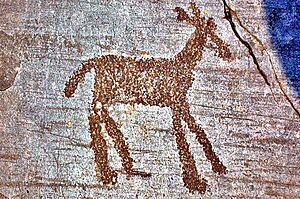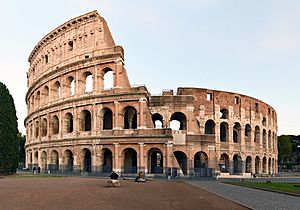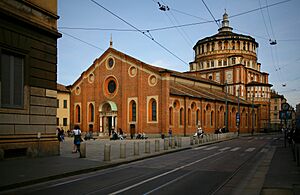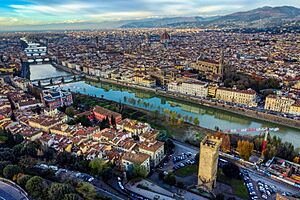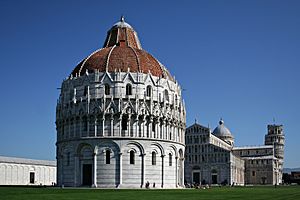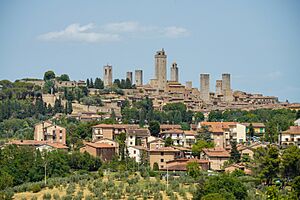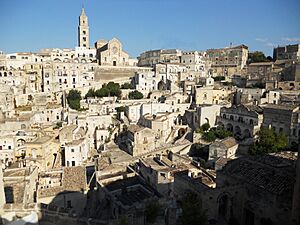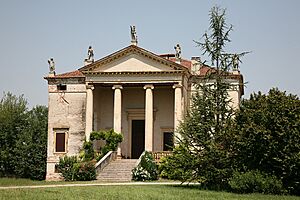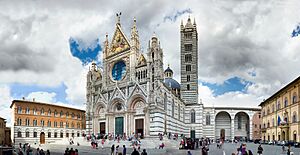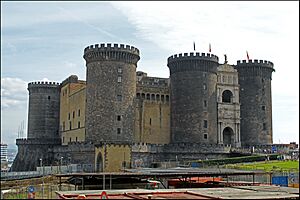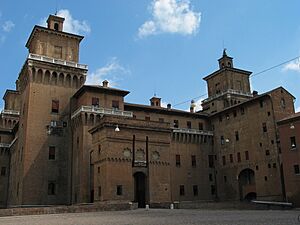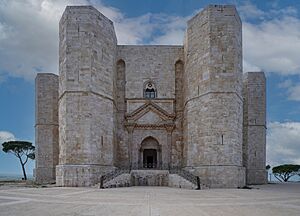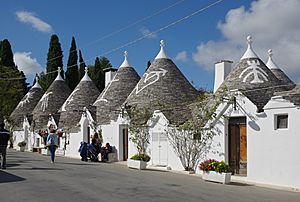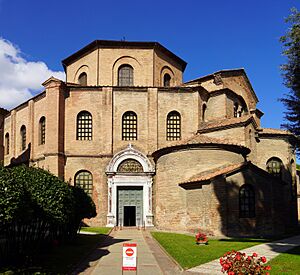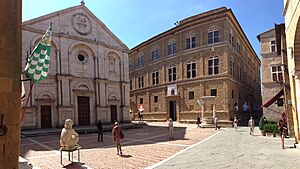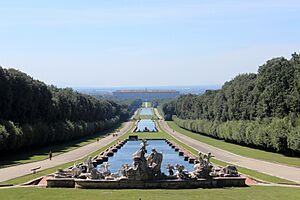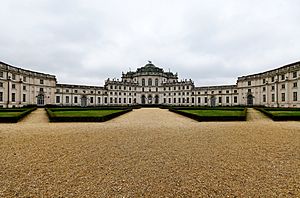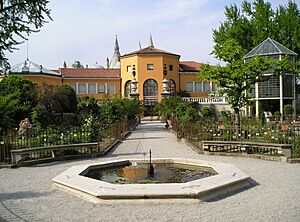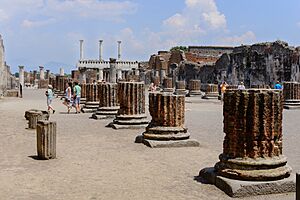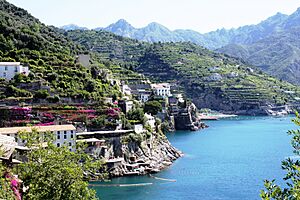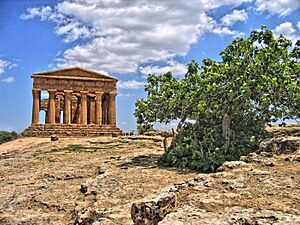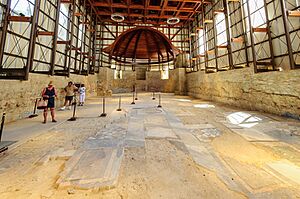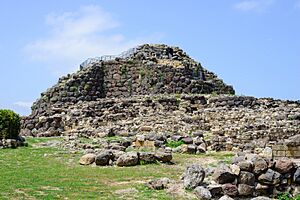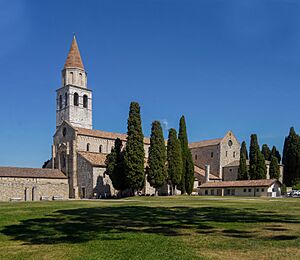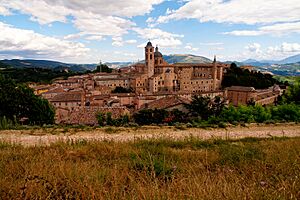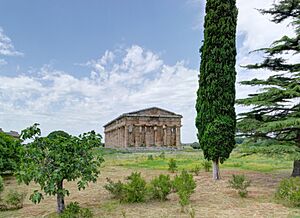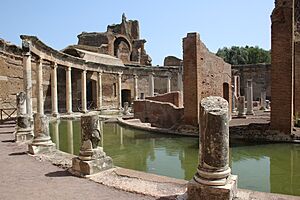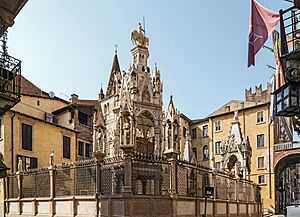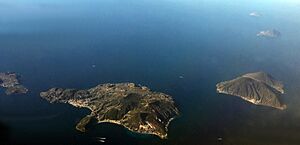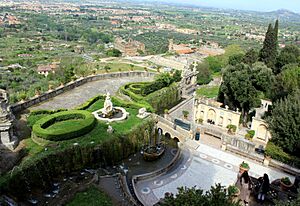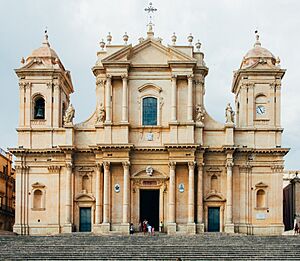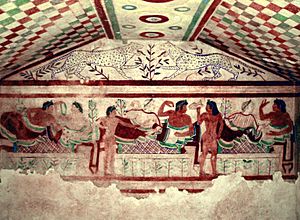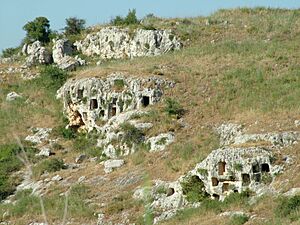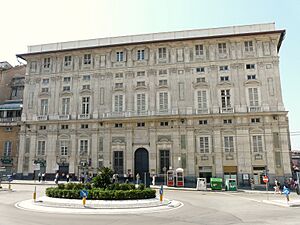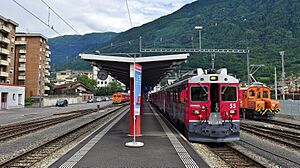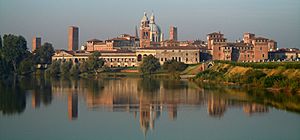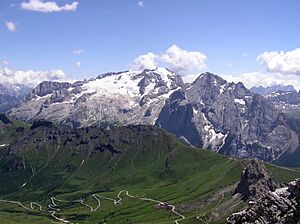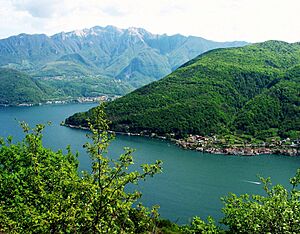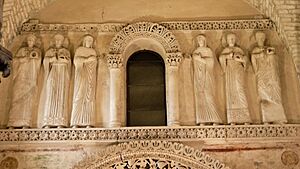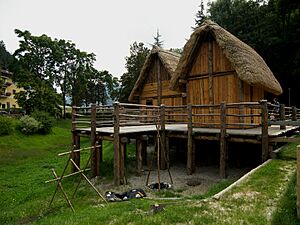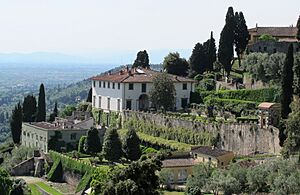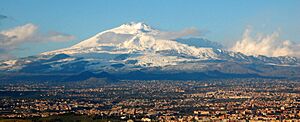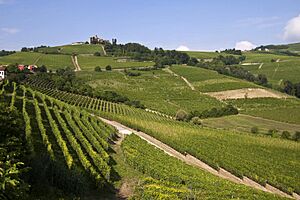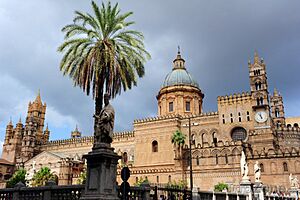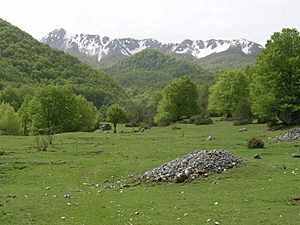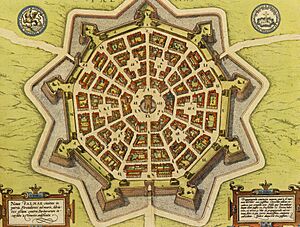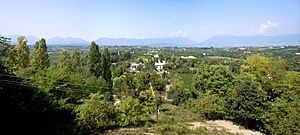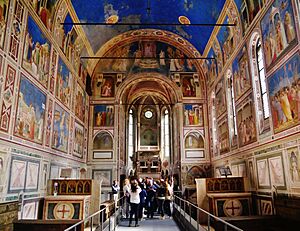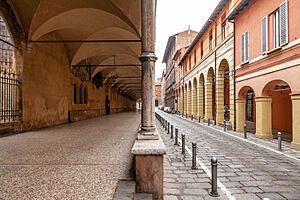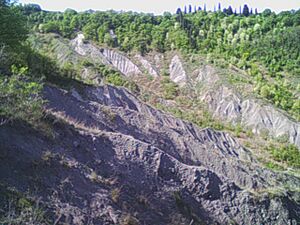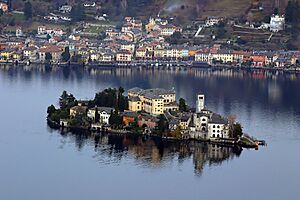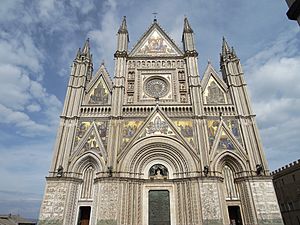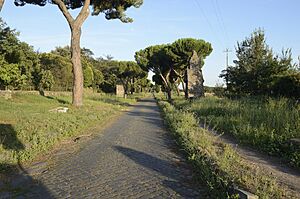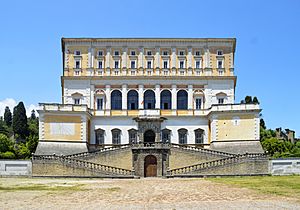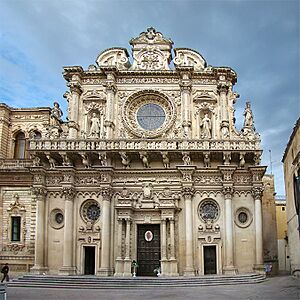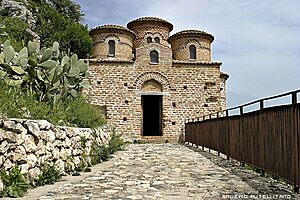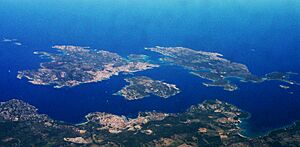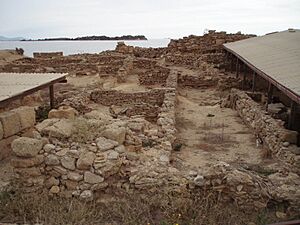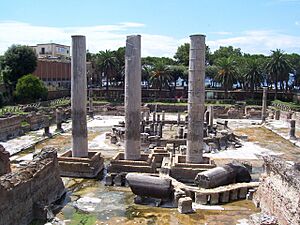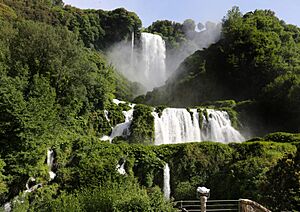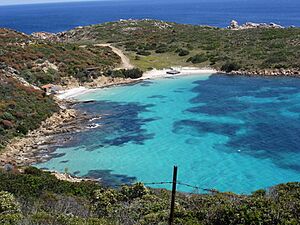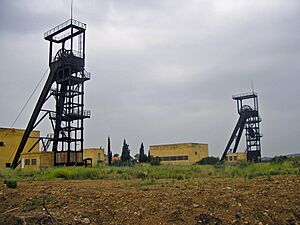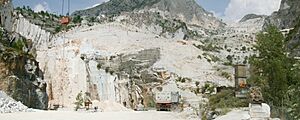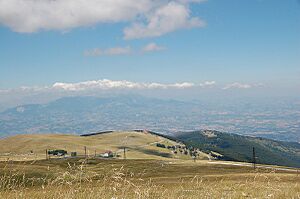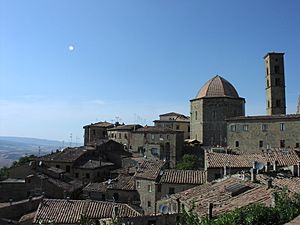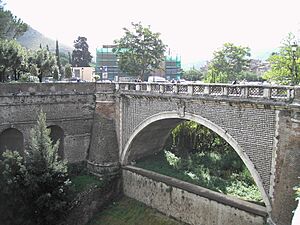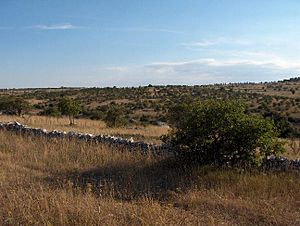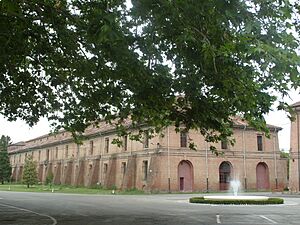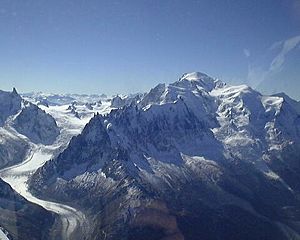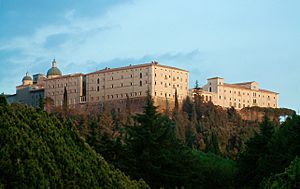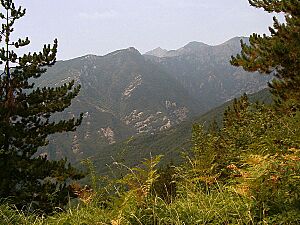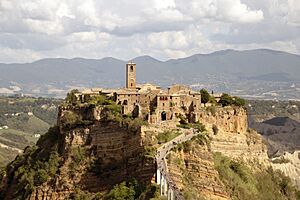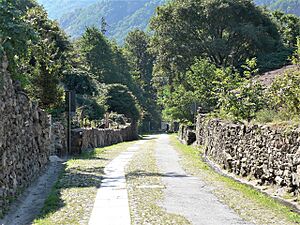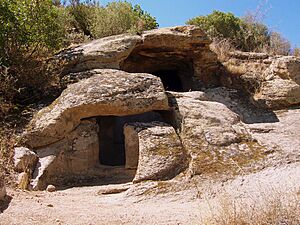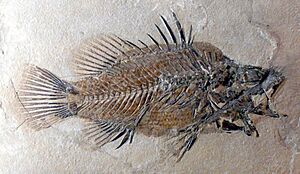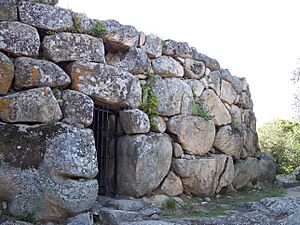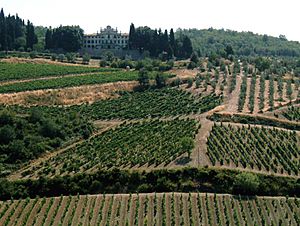List of World Heritage Sites in Italy facts for kids
Italy is home to many amazing places recognized by UNESCO as World Heritage Sites. These special places are important for their culture or natural heritage. They are chosen because they show something unique about human history, art, or the natural world.
Italy has 59 World Heritage Sites as of 2023. This means Italy has more of these sites than any other country! The very first site in Italy, the Rock Drawings in Valcamonica, was added in 1979. Many sites were added in the 1990s, showing how rich Italy is in history and nature.
Most of Italy's sites are cultural, like old buildings or historic towns. Six are natural, like mountains or islands. Seven sites are shared with other countries. For example, the Historic Centre of Rome is shared with the Vatican City. The Dolomites are a natural site, and the Prehistoric pile dwellings around the Alps are shared with five other countries. Italy also has 31 sites that might become World Heritage Sites in the future.
Contents
Exploring Italy's World Heritage Sites
UNESCO chooses sites based on ten different rules. Each site must meet at least one of these rules. Rules one to six are for cultural sites, and rules seven to ten are for natural sites. * This site is shared with other countries!
| Site Name | Picture | Location | Year Added | UNESCO ID | What Makes It Special |
|---|---|---|---|---|---|
| Rock Drawings in Valcamonica | Brescia | 1979 | 94; iii, vi (cultural) | Valcamonica has one of the world's largest collections of petroglyphs. These are carvings made on rocks. Over 140,000 carvings were made over 8,000 years. They show scenes of farming, sailing, war, and magic. | |
| Historic Centre of Rome, and Vatican City Sites* | Metropolitan City of Rome Capital | 1980 | 91ter; i, ii, iii, iv, vi (cultural) | Rome was the heart of the Roman Empire and later the Christian world. It has many ancient buildings like the Colosseum (pictured). You can also see amazing buildings from the Renaissance and Baroque periods. This site is shared with Vatican City. | |
| Church and Convent of Santa Maria delle Grazie with "The Last Supper" | Metropolitan City of Milan | 1980 | 93; i, ii (cultural) | This church and convent in Milan were built in the 1400s. Inside, you can see Leonardo da Vinci's famous painting, The Last Supper. It's a true masterpiece of art. | |
| Historic Centre of Florence | Metropolitan City of Florence | 1982 | 174ter; i, ii, iii, iv, vi (cultural) | Florence is known as the birthplace of the Renaissance. It greatly influenced art and architecture in Europe. Famous artists like Michelangelo worked here. Key places include the Florence Cathedral and the Uffizi art gallery. | |
| Venice and its Lagoon | Metropolitan City of Venice | 1987 | 394; i, ii, iii, iv, v, vi (cultural) | Venice was built on over 100 islands in a lagoon. It became a powerful trading city in the 900s. It has famous landmarks like St Mark's Basilica. Venice also inspired many great painters. | |
| Piazza del Duomo, Pisa | Pisa | 1987 | 395bis; i, ii, iv, vi (cultural) | This square in Pisa has four amazing medieval buildings. They are the cathedral, the baptistry, the cemetery, and the famous leaning tower. These buildings influenced other cities in Tuscany. | |
| Historic Centre of San Gimignano | Siena | 1990 | 550; i, iii, iv (cultural) | San Gimignano was an important stop for travelers in the Middle Ages. It still looks like a medieval town with its tall towers. Fourteen of these towers still stand today. | |
| The Sassi and the Park of the Rupestrian Churches of Matera | Matera | 1993 | 670; iii, iv, v (cultural) | This site in Matera has cave dwellings first used in the Stone Age. People lived in natural caves and later built more complex structures. These include churches carved into the rock. | |
| City of Vicenza and the Palladian Villas of the Veneto | Padua, Rovigo, Treviso, Metropolitan City of Venice, Verona, Vicenza | 1994 | 712; i, ii (cultural) | In the 1500s, architect Andrea Palladio built many villas in Vicenza and the Veneto region. His designs greatly influenced architecture worldwide. This style is now called Palladian. | |
| Historic Centre of Siena | Siena | 1995 | 717; i, ii, iv (cultural) | The city of Siena has kept its medieval Gothic look from the 1100s to 1400s. The city is built around the Piazza del Campo. Many important painters were born or worked in Siena. | |
| Historic Centre of Naples | Metropolitan City of Naples | 1995 | 726bis; ii, iv (cultural) | Naples was founded by Greek settlers in 470 BCE. It was a very important city for centuries. It has many famous buildings like the Castel Nuovo (pictured) from the 1200s. | |
| Crespi d'Adda | Bergamo | 1995 | 730; iv, v (cultural) | Crespi d'Adda is a well-preserved company town from the 1800s and 1900s. It was built for workers of a textile factory. The town had homes, a clinic, a school, and a theater. | |
| Ferrara, City of the Renaissance, and its Po Delta | Ferrara | 1995 | 733bis; ii, iii, iv, v, vi (cultural) | Ferrara was a center for art and learning during the Italian Renaissance. It attracted many artists. The Este Castle (pictured) is a famous example. The site also includes the beautiful landscape of the Po Delta. | |
| Castel del Monte | Barletta-Andria-Trani | 1996 | 398rev; i, ii, iii (cultural) | This unique octagonal castle was built in the 1200s by Emperor Frederick II. It mixes different building styles from Europe, Muslim lands, and ancient Rome. | |
| The Trulli of Alberobello | Bari | 1996 | 787; iii, iv, v (cultural) | Trulli are traditional limestone huts found in the Apulia region. They have unique conical roofs made of stone slabs. The town of Alberobello has over 1500 of these preserved structures. | |
| Early Christian Monuments of Ravenna | Ravenna | 1996 | 788; i, ii, iii, iv (cultural) | This site has eight monuments in Ravenna, which was an important city in the 400s. The churches and tombs are decorated with amazing mosaics. These mosaics blend Western and Byzantine art styles. | |
| Historic Centre of the City of Pienza | Siena | 1996 | 789; i, ii, iv (cultural) | In 1459, Pope Pius II decided to rebuild his hometown of Pienza. He used new Renaissance ideas for city design. Pienza later became a model for other cities in Italy and Europe. | |
| 18th-Century Royal Palace at Caserta with the Park, the Aqueduct of Vanvitelli, and the San Leucio Complex | Caserta and Benevento | 1997 | 549rev; i, ii, iii, iv (cultural) | This huge palace complex was built in the 1700s for the King of Naples. It was inspired by palaces like Versailles. The site also includes an aqueduct and a silk factory. | |
| Residences of the Royal House of Savoy | Metropolitan City of Turin, Cuneo | 1997 | 823bis; i, ii, iv, v (cultural) | This site includes 22 palaces and villas built by the House of Savoy royal family. They wanted to show their power after moving their capital to Turin in 1562. These buildings are great examples of 17th and 18th-century European architecture. | |
| Botanical Garden (Orto Botanico), Padua | Padua | 1997 | 824; ii, iii (cultural) | Padua's botanical garden was started in 1545. It was the world's first university botanical garden. It has been a center for science and a model for other gardens for centuries. | |
| Portovenere, Cinque Terre, and the Islands (Palmaria, Tino and Tinetto) | La Spezia | 1997 | 826bis; ii, iv, v (cultural) | The beautiful landscape along the Ligurian coast has been shaped by people for over a thousand years. It has charming small towns built on steep hillsides. There are also three islands with old monastic buildings. | |
| Cathedral, Torre Civica and Piazza Grande, Modena | Modena | 1997 | 827; i, ii, iii, iv (cultural) | This complex from the 1100s is a great example of early Romanesque art. It had a big impact on this style of architecture. The cathedral was designed by Lanfranco and decorated by Wiligelmo. | |
| Archaeological Areas of Pompei, Herculaneum and Torre Annunziata | Metropolitan City of Naples | 1997 | 829; iii, iv, v (cultural) | These three sites were buried by volcanic ash when Mount Vesuvius erupted in 79 CE. The towns of Pompeii and Herculaneum were perfectly preserved. They show us what life was like in the 1st century CE. | |
| Amalfi Coast (Costiera Amalfitana) | Salerno | 1997 | 830; ii, iv, v (cultural) | The beautiful Mediterranean landscape of the Amalfi Coast was shaped over centuries. It blends Western and Byzantine influences. The coast has charming towns like Amalfi and Ravello. | |
| Archaeological Area of Agrigento | Agrigento | 1997 | 831; i, ii, iii, iv (cultural) | Agrigento was a Greek colony founded in the 500s BCE. It became one of the most important cities in the Mediterranean. Several Doric temples are still standing here. | |
| Villa Romana del Casale | Enna | 1997 | 832; i, ii, iii (cultural) | This villa in Piazza Armerina is one of the most luxurious Roman villas from the early 300s CE. It is famous for its amazing mosaics. These mosaics are the best collection of Roman mosaics still in their original place. | |
| Su Nuraxi di Barumini | South Sardinia | 1997 | 833; i, iii, iv (cultural) | Su Nuraxi is the best example of a nuraghe. These are ancient stone defense structures from the Bronze Age (around 2000 BCE). They are unique to Sardinia. | |
| Archaeological Area and the Patriarchal Basilica of Aquileia | Udine | 1998 | 825ter; iii, iv, vi (cultural) | Aquileia was a very rich city in the early Roman Empire. The Patriarchal Basilica has amazing mosaic floors from the 300s. It helped spread Christianity in Central Europe during the early Middle Ages. | |
| Historic Centre of Urbino | Pesaro and Urbino | 1998 | 828; ii, iv (cultural) | In the 1400s, Urbino became a center for humanists, scientists, and artists. The city's Renaissance architecture has been well preserved. This is because Urbino's growth slowed down after the 1500s. | |
| Cilento and Vallo di Diano National Park with the Archeological sites of Paestum and Velia, and the Certosa di Padula | Salerno | 1998 | 842; iii, iv (cultural) | This landscape was shaped by different groups over centuries, including Greeks and Romans. It includes the ruins of Paestum and Velia, two important ancient towns. The Certosa di Padula is a large monastery from the 1300s. | |
| Villa Adriana, Tivoli | Metropolitan City of Rome Capital | 1999 | 907; i, ii, iii (cultural) | Hadrian's Villa in Tivoli was built in the 100s CE as a retreat for Emperor Hadrian. It mixes architectural styles from Greece, Egypt, and Rome. Its rediscovery influenced Renaissance architects. | |
| City of Verona | Verona | 2000 | 797rev; ii, iv (cultural) | Verona has been developing for over 2,000 years. It has buildings and structures from many different periods. These include a Roman amphitheater and Gothic Scaliger Tombs (pictured). | |
| Isole Eolie (Aeolian Islands) | Messina | 2000 | 908; viii (natural) | These islands off the coast of Sicily are important for studying volcanoes. They show many types of volcanic landforms. Two types of eruptions, Strombolian and Vulcanian, are named after these islands. | |
| Assisi, the Basilica of San Francesco and Other Franciscan Sites | Perugia | 2000 | 990; i, ii, iii, iv, vi (cultural) | Assisi is the birthplace of Saint Francis, who started the Franciscan order. The Basilica was built in the 1200s. It has famous paintings by artists like Giotto. | |
| Villa d'Este, Tivoli | Metropolitan City of Rome Capital | 2001 | 1025; i, ii, iii, iv, vi (cultural) | The gardens of Villa d'Este from the 1500s are some of the best examples of Italian Renaissance gardens. They have a geometric design with many pools and fountains. They greatly influenced garden design in Europe. | |
| Late Baroque Towns of the Val di Noto (South-Eastern Sicily) | Catania, Ragusa, Syracuse | 2002 | 1024; i, ii, iv, v (cultural) | In 1693, a strong earthquake destroyed many towns in Sicily. Afterward, towns like Noto and Ragusa were rebuilt in the beautiful Baroque style. They show the peak of late Baroque art in Europe. | |
| Sacri Monti of Piedmont and Lombardy | several sites | 2003 | 1068rev; ii, iv (cultural) | Sacri Monti (Sacred Mountains) are groups of chapels and other buildings. They were built from the late 1400s to 1600s as places for pilgrims to visit. They are rich in art and blend well with the landscape. | |
| Val d'Orcia | Siena | 2004 | 1026rev; iv, vi (cultural) | The landscape of Val d'Orcia was carefully redesigned in the 1300s and 1400s. It followed the ideas of the Renaissance. It has small villages, fields, and farms, and has been featured in many paintings. | |
| Etruscan Necropolises of Cerveteri and Tarquinia | Viterbo, Metropolitan City of Rome Capital | 2004 | 1158; i, iii, iv (cultural) | These are two ancient cemeteries of the Etruscans from 800s to 1 BCE. Many tombs look like Etruscan houses. They have amazing wall paintings showing daily life, like the Tomb of the Leopards (pictured). | |
| Syracuse and the Rocky Necropolis of Pantalica | Syracuse | 2005 | 1200; ii, iii, iv, vi (cultural) | Syracuse was founded in the 700s BCE and became a very important Greek city. The Necropolis of Pantalica (pictured) has over 5,000 tombs, mostly from 1200s to 600s BCE. | |
| Genoa: Le Strade Nuove and the system of the Palazzi dei Rolli | Metropolitan City of Genoa | 2006 | 1211; ii, iv (cultural) | This site in Genoa shows urban planning from the 1500s and 1600s. Le Strade Nuove (New Streets) are a group of streets built by rich families. The Palazzi dei Rolli are palaces used to host important guests. | |
| Rhaetian Railway in the Albula / Bernina Landscapes* | Sondrio | 2008 | 1276; ii, iv (cultural) | The Albula and Bernina railway lines cross the Swiss Alps. They were built in the early 1900s. Building them involved amazing engineering with bridges and tunnels. This site is shared with Switzerland. | |
| Mantua and Sabbioneta | Mantua | 2008 | 1287; ii, iii (cultural) | These two towns show different ways of city planning during the Renaissance. Mantua (pictured) was an older city that was updated. Sabbioneta was a new city built from scratch with an "ideal city" plan. | |
| The Dolomites | several sites | 2009 | 1237rev; vii, viii (natural) | This site includes nine areas of the Dolomites, a mountain range in the northern Italian Alps. They have tall cliffs, vertical walls, and narrow valleys. Geologically, their rocks hold fossils of ancient marine life. | |
| Monte San Giorgio* | Varese | 2010 | 1090; viii (natural) | Monte San Giorgio has the best collection of fossils from marine life during the Triassic Period (245–230 million years ago). Back then, this area was a tropical lagoon full of reptiles and fish. This site is shared with Switzerland. | |
| Longobards in Italy. Places of the power (568-774 A.D.) | several sites | 2011 | 1318; ii, iii, vi (cultural) | This site includes seven groups of monasteries, churches, and forts. They are linked to the Longobards, who ruled Italy from the 500s to 700s. Their art and buildings show a mix of Roman, Christian, and Germanic styles. | |
| Prehistoric Pile dwellings around the Alps* | several sites | 2011 | 1363; iv, v (cultural) | This site (shared with Austria, France, Germany, Slovenia, and Switzerland) has remains of ancient pile-dwelling villages. These villages were built on lake edges or wetlands from around 5000 to 500 BCE. They tell us a lot about early farming cultures. | |
| Medici Villas and Gardens in Tuscany | several sites | 2013 | 175; ii, iv, vi (cultural) | This site includes twelve villas and two gardens built by the powerful Medici family in Tuscany. They were new types of homes for rich families, designed for fun, art, and learning. They followed Renaissance humanism ideas. | |
| Mount Etna | Catania | 2013 | 1427; viii (natural) | Mount Etna is the world's most active stratovolcano. It has been studied for at least 2,700 years. It shows many typical volcanic features like lava flows and caves. The mountain is also home to unique plants and animals. | |
| Vineyard Landscape of Piedmont: Langhe-Roero and Monferrato | Alessandria, Asti, Cuneo | 2014 | 1390rev; iii, v (cultural) | People have been growing grapes and making Piemonte wine here since at least 400 BCE. The landscape has vineyards, villages, and old churches. It includes five wine-producing areas and the Castle of Grinzane Cavour. | |
| Arab-Norman Palermo and the Cathedral Churches of Cefalù and Monreale | Metropolitan City of Palermo | 2015 | 1487; ii, iv (cultural) | This site has nine buildings from the Norman Kingdom of Sicily (1130–1194). Their style mixes Arab, Byzantine, and Western art. It includes palaces, churches, and cathedrals like Palermo Cathedral (pictured). | |
| Ancient and Primeval Beech Forests of the Carpathians and Other Regions of Europe* | several sites | 2017 | 1133ter; ix (natural) | These ancient beech forests help us understand how beech trees have grown over the last million years. This site is shared with 17 other countries. The 13 forests in Italy were added in 2017 and 2021. | |
| Venetian Works of Defence between the 16th and 17th centuries: Stato da Terra – Western Stato da Mar* | Bergamo, Udine, Verona | 2017 | 1533; iii, iv (cultural) | This site includes six defense structures in Italy, Croatia, and Montenegro. They were built between the 1500s and 1600s. Their design changed because of gunpowder warfare. In Italy, it includes the star fort of Palmanova (map pictured). | |
| Ivrea, Industrial City of the 20th Century | Metropolitan City of Turin | 2018 | 1538bis; iv (cultural) | The Industrial City of Ivrea was founded in 1908 by Camillo Olivetti for his company. The city was designed to show a modern way of connecting factories and architecture. It includes homes, public buildings, and industrial sites. | |
| The Prosecco Hills of Conegliano and Valdobbiadene. | Treviso | 2019 | 1571rev; v (cultural) | This cultural landscape has unique terraced hills used for vineyards since the 1600s. This region is famous for producing Prosecco wine. The landscape also has forests, hedges, and villages. | |
| The Great Spa Towns of Europe* | Pistoia | 2021 | 1613; ii, iii, iv, vi (cultural) | This site includes 11 spa towns in seven European countries. People used mineral waters here for healing before modern medicine. The town of Montecatini Terme is Italy's part of this site. | |
| Padua's fourteenth-century fresco cycles | Padua | 2021 | 1623; ii (cultural) | This site has eight buildings with amazing fresco paintings from the 1300s. Artists like Giotto painted these. The frescos are special because they show new ways of telling stories and using perspective. | |
| The Porticoes of Bologna | Metropolitan City of Bologna | 2021 | 1650; iv (cultural) | Porticoes are covered walkways that are an important part of Bologna's history and architecture. For centuries, they have been used for walking and for shops. Twelve portico complexes are listed. | |
| Evaporitic Karst and Caves of Northern Apennines | several sites | 2023 | 1692; viii (natural) | This site has four areas with special karst landscapes made of salt and gypsum. There are over 700 caves with unique minerals. These caves are home to many rare and endangered plant species. |
Future World Heritage Sites: Italy's Tentative List
Besides the sites already on the World Heritage List, countries can suggest new places. These suggested places go on a "tentative list." A site must be on this list before it can be considered for the main World Heritage List. As of 2021, Italy has 31 sites on its tentative list.
| Site Name | Picture | Location | Year Added | UNESCO Criteria | What Makes It Special |
|---|---|---|---|---|---|
| Lake Maggiore and Lake D'Orta Lakelands | Novara, Verbano-Cusio-Ossola | 2006 | ii, vi (cultural) | The beautiful landscape around these lakes has been shaped since the 1500s. Rich owners built villas and gardens on the shores and islands. Since the 1800s, it has been a popular holiday spot. | |
| Hanbury Botanical Gardens | Imperia | 2006 | ii, iv (cultural) | These botanical gardens were created in the late 1800s. The goal was to grow exotic plants from other parts of the world and do plant experiments. These gardens became a model for others. | |
| Orvieto | Terni | 2006 | i, iv, v (cultural) | Orvieto was an Etruscan town that was very important between the 500s and 300s BCE. In the Middle Ages, it became important again. The cathedral (pictured) with its highly decorated front is a masterpiece of Italian Gothic architecture. | |
| Via Appia "Regina Viarum" | several sites | 2006 | i, ii, iv, v, vi (cultural) | The Via Appia was one of the first and most important Roman roads. Built in 312 BCE, it connected Rome to Brindisi. It was a revolutionary design, with bridges and viaducts, and was paved with stone. | |
| Villas of the Papal Nobility | Viterbo, Metropolitan City of Rome Capital | 2006 | i, ii, iii, iv (cultural) | This site includes 15 villas built from the mid-1500s for important church leaders and nobles. Famous architects like Gian Lorenzo Bernini designed them. These villas usually have beautiful parks and gardens. | |
| Salento and the "Barocco Leccese" | Lecce | 2006 | i, iii, iv (cultural) | The Salento area has been shaped by many cultures over centuries. A special feature is the "Barocco Leccese," a type of Baroque style that developed in Lecce. It is very decorative and shows the power of the Catholic Church. | |
| Cattolica Monastery in Stilo and Basilian-Byzantine Complexes | Reggio Calabria | 2006 | ii, iii, iv (cultural) | Between the 500s and 1000s, Calabria was influenced by the Byzantine Empire. This can be seen in the church architecture and monasteries, often built in caves. These sites attracted hermits from other lands. | |
| Archipelago of La Maddalena and Islands of Bocche di Bonifacio* | Sassari | 2006 | vii, ix, x (natural) | This group of islands is located between Sardinia and Corsica. It is shared between Italy and France. The area is an important home for different types of whales and other sea animals. | |
| Mothia Island and Lilibeo: The Phoenician-Punic Civilization in Italy | Trapani | 2006 | iii, iv, vi (cultural) | Mothia was a Punic settlement on an island near Sicily, founded in the 600s BCE. Many carved stones have been found here. The town was later attacked, and survivors moved to Lilibeo. | |
| Bradyseism in the Flegrea Area | Metropolitan City of Naples | 2006 | vii, viii, x (natural) | Bradyseism is when the land slowly moves up or down because of magma chambers underground. This can be seen at the Macellum of Pozzuoli (pictured), a Roman monument. Holes made by sea creatures on its columns show that the area was once underwater. | |
| Cascata delle Marmore and Valnerina: Monastic sites and ancient hydrogeological reclamation works | Perugia, Terni | 2006 | i, iv, v, vi (cultural) | The Valnerina valley attracted monks in the 300s. They changed the land by draining marshes and moving rivers to create farmland. The Cascata delle Marmore (pictured) is an artificial waterfall created in 271 BCE to prevent floods. | |
| Pelagos: The Cetacean Sanctuary* | several sites | 2006 | vii, ix, x (natural) | This protected area off the coast of Liguria, Sardinia, and Tuscany is shared with Monaco and France. It is a vital home for many species of whales and other marine animals. | |
| Island of Asinara | Sassari | 2006 | vii, ix, x (natural) | This island off the coast of Sardinia is geologically interesting. It has rare black rocks that are 950 million years old. The island has been used for various purposes throughout history, including as a prison. | |
| Sulcis Iglesiente | Oristano, Cagliari | 2006 | ix, x (natural) | Iglesiente, in Sardinia, is Italy's most important mining area. People have mined lead, zinc, and silver here since ancient times. Coal mines were set up in the 1800s. | |
| The Marble Basin of Carrara | Massa-Carrara | 2006 | ii, vi, vii, viii, ix, x (mixed) | High-quality marble has been taken from the Apuan Alps around Carrara since Roman times. There are many quarry sites from the Renaissance period. The area also preserves old mining tools and methods. | |
| The Transhumance: The Royal Shepherd's Track | several sites | 2006 | ii, iii, x (mixed) | Transhumance is when shepherds move their animals between summer and winter pastures. This practice has been done in Italy since before Roman times. Shepherd's tracks connect a network of roads with places like taverns and sanctuaries. | |
| Volterra: Historical City and Cultural Landscape | Pisa | 2006 | iv, v (cultural) | Volterra is a hilltop town settled by the Etruscans and later by the Romans. A Roman theater is still visible. In the 1400s, a Renaissance fortress was built. Today, the town mostly looks medieval. | |
| The Aniene Valley and Villa Gregoriana in Tivoli | Metropolitan City of Rome Capital | 2006 | i, ii, iii, iv (cultural) | The Aniene valley was an important source of water for Rome. The first aqueduct was built here in the 100s BCE. There are also Roman temples. Villa Gregoriana (bridge pictured) is a park created in 1835 to manage the Aniene river after a flood. | |
| The Murge of Altamura | Metropolitan City of Bari | 2006 | iii, vii, viii (mixed) | Murge is a karst plateau with caves and sinkholes. Thousands of dinosaur footprints from 70 million years ago have been found here. The Altamura Man, a complete skeleton of a Neanderthal man, was discovered in 1993. | |
| Karstic Caves in Prehistoric Apulia | Lecce | 2006 | i, ii, iii (cultural) | The Salento area has many caves due to its limestone. Caves like Grotta Romanelli and Grotta delle Veneri were lived in during the Stone Age. Tools, bones, and stone carvings have been found. Grotta dei Cervi (pictured) has ancient rock art. | |
| Citadel of Alessandria | Alessandria | 2006 | ii, iii, iv (cultural) | This bastion fort near Alessandria was built in 1713. It was expanded by the French under Napoleon. The fort played a role in the 1859 Second Italian War of Independence. | |
| Mont Blanc massif* | Aosta Valley | 2008 | vii, viii, ix, x (natural) | Mont Blanc is the highest peak in the Alps, standing at 4,810 meters. The area has many glaciers and is an important home for mountain plants and animals. This nomination is shared with France and Switzerland. | |
| The Cultural Landscape of the Benedictine Settlements in Medieval Italy | several sites | 2016 | ii, v, vi (cultural) | This nomination includes eight monasteries of the Benedictines, a religious order founded in the 500s. These monasteries were centers of culture and learning. They also created a special landscape that showed how people lived with nature. | |
| Mediterranean Alps* | Cuneo, Imperia | 2017 | viii (natural) | This nomination, shared with France and Monaco, covers parts of the Maritime Alps and Ligurian Alps. These mountains are interesting because they formed 30 million years ago. They drop from over 3,000 meters to the Mediterranean Sea in less than 70 kilometers. | |
| The Cultural Landscape of Civita di Bagnoregio | Viterbo | 2017 | iii, v (cultural) | Civita di Bagnoregio is a town on a hilltop that has been settled since Etruscan times. The land is made of soft rock and clay, which can cause landslides. The town shows how people have fought against a changing environment. | |
| Via Francigena in Italy | several sites | 2019 | ii, iv, vi (cultural) | The Via Francigena was a network of roads used by pilgrims in the Middle Ages. They traveled from France to Rome. These pilgrimages helped share culture between Italy and Northern Europe. | |
| Art and Architecture in the Prehistory of Sardinia. The domus de janas. | several sites | 2021 | ii, iii, vi (cultural) | This nomination includes sites from ancient cultures in Sardinia, from the Stone Age to the Bronze Age. They include large stone structures like menhirs and dolmens. The Domus de Janas are special underground tombs, some with painted walls. | |
| Eocene Marine Biodiversity of the Alpone Valley | Verona, Vicenza | 2021 | viii (natural) | The area around Verona is rich in fossils from the Eocene epoch (56 to 34 million years ago). These fossils show a tropical ocean ecosystem with fish, marine mammals, and other sea creatures. Scientists have been studying these fossils since the 1500s. | |
| Historical Theatres of the Marche Region | several sites | 2021 | ii, iv, vi (cultural) | This nomination includes 61 theaters in the Marche region. They were built from the 1500s to 1800s. The design of these theaters changed over time. People from all social classes visited them. | |
| Nuragic Monuments of Sardinia | several sites | 2021 | ii, iv, v (cultural) | This nomination includes 31 sites from the Nuragic civilization of Sardinia from the 2nd millennium BCE. The main feature of this civilization is the nuraghe, which are large stone defense structures. | |
| The system of the Ville-fattoria in Chianti Classico | Florence, Siena | 2023 | ii, iv, v (cultural) | This landscape was developed in the 1500s. It uses a "Villa-fattoria" system, where farming was organized around large villas. The hilly land is perfect for making Chianti wine. |
See also
 In Spanish: Anexo:Patrimonio de la Humanidad en Italia para niños
In Spanish: Anexo:Patrimonio de la Humanidad en Italia para niños


